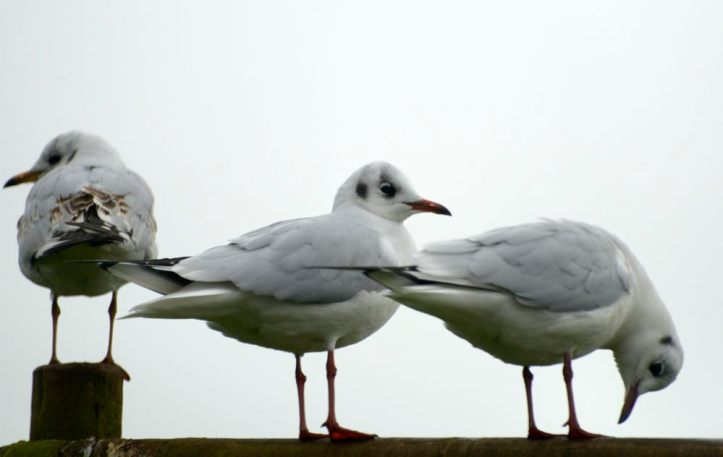
.
Lynn Wohlers (at bluebrightly) and I are WordPress bloggers who appreciate each other’s photography – and who are both ex-birders / birdwatchers. And as Lynn tells me that she’s probably going to miss a Black-headed Gull in her local area – a rare bird in The States but a very common one in the UK – here are for her three at Chew Valley Lake, near Bristol, last Friday (5 Feb 2016).
We’d gone out for a little drive around on a wet and windy day and ended up in the car park of a café beside this large lake, where there were many of these small gulls weathering out the storm atop wooden fences. The birds seemed unconcerned by our presence and so, before we went in for cakes and pots of hot tea, I took some pictures. Rain was pouring across the car’s windscreen and I was shooting between the flailing windscreen wipers – catching the wiped screen just after each wiper had passed.
These are Black-headed Gulls in winter plumage. The two on the right are adults, with grey and white plumage (+ some black around the wingtips) and the distinctive dark spot behind the eye (to birders, on the ear coverts); the legs and the base of the bill are reddish. The bird on the left has some dark brown in its plumage – it began life last summer and is now changing from its immature plumage more towards the attire of a subadult.
So, Lynn, maybe not as good as seeing the real thing – tho you and I no longer relish standing around in freezing conditions so much hoping for glimpses of feathered friends – but, nevertheless, ENJOY!!!
Click onto the image to see a larger version in a separate window.
D800 with 70-300 Nikkor at 300mm; 800 ISO.
.
.
.
Wow, HOW DID I MISS THIS? I feel bad! Thank you for posting. And now I’m waiting to see breeding plumage photos, OK? 😉
LikeLike
Haha! >>> breeding plumage might be more difficult but we’ll see! This gull breeds widely in the UK but not near Bristol, so most of our’s disappear for the first part of the summer – and I always think its a sign of the year changing when they re-appear in late summer – I’ll keep my eyes out! But, in any case and despite their name, these gulls don’t have the magnificent black heads that some of your American gulls have, the “black” is in fact dark brown! 🙂
LikeLike
very good
LikeLike
Thank you! 🙂
LikeLike
They make an excellent Trio, Adrian. I wonder how long you had to wait fro them to assume that composition?
LikeLike
This is very much a snapshot, Andy – taking through a wet windscreen and flailing wipers – a lucky pose! Adrian
LikeLike
Considering the conditions under which it was shot I’m amazed at the quality.
LikeLike
What I recommend in cases like these, Andy, is getting the camera lens right up as close to the glass of the window as possible, and then using the smallest possible depth of focus – which I think was f5.6 here. Adrian
LikeLike
They arranged themselves nicely for you, Adrian. Most unusual!!
LikeLike
Well I had to yell at them a bit but, you know, they usually do what I say … 🙂
LikeLike